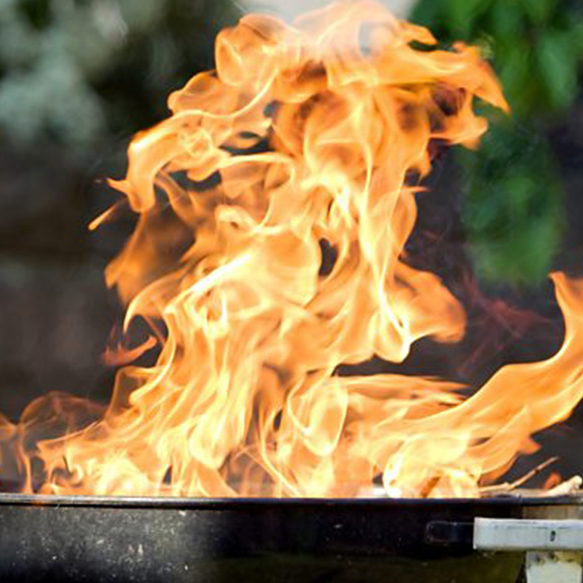But is it possible to enjoy the smoky, sizzling flavours of a barbecue and all the trimmings without putting yourself at risk of food poisoning, heart disease, obesity or cancer?
Is there a cancer risk from barbecued meats?
Carcinogenic chemicals called Polycyclic Aromatic Hydrocarbons (PAHs) are generated when organic substances are burned. On a barbecue this includes the fats and meat you are cooking plus the wood or charcoal.
Cooking food close to the coals, in a smoky environment or for prolonged periods, can create high levels of PAHs in your food. This in turn may increase your risk of cancer.
There are ways to minimise your exposure to PAHs from the barbecue. Part-cooking food indoors will limit the amount of time it is exposed to the smoke. Gas barbecues create fewer PAHs than charcoal or wood chips. Marinating meat also cools its surface to stop PAHs forming.
Your choice of meat can have an impact, too. Not only do burgers and sausages show the highest levels of PAHs during barbecuing, eating processed and red meat also increases the risk of bowel cancer. Switch to barbecued fish, lean beef or chicken.
Burgers have the highest levels of carcinogenic ‘PAHs’, as the fat drips down onto the coals and coats the craggy surface area of the meat
Are barbecues to blame for food poisoning?
Cases of food poisoning double in the summer. Is this down to the barbecue?
Clean grill
The heat of the coals is not suitable for killing all germs. Cleaning the grill is easiest after a quick pre-heat, before your cooking starts. The heat will loosen charred-on grease.
A clean grill will also leave beautiful char-marks on your food. A dirty grill will leave bits of last week’s dinner!
Raw or cooked?
Raw and cooked foods should never touch each other or share the same plate. Once you’ve transferred any raw meat to the barbecue, wash the plate and tongs with hot, soapy water before they come into contact with any cooked meat.
Give raw food enough space. Consider having separate raw and cooked sides of the barbecue so that cooked foods can be held at a medium-hot temperature until ready to serve.
Marinades
In the summer, marinate meat in the fridge unless it’s being done for a very short time. Bacteria grows at room temperature fast enough to cause food poisoning in less than an hour.
An hour is long enough to marinate small cuts of meat and kebabs. Larger pieces of meat can be marinated overnight.
Don’t use the marinade from the raw meat as a sauce for basting meat while it’s cooking. If you want to baste your meat on the grill, use a new mixture and a clean brush.
Use a cooking thermometer to check meat is cooked through, never baste food with a marinade that’s had raw meat in it, keep raw and cooked foods apart and ensure your grill and brush are clean.
Pre-cook it
If you take one tip away from this guide, it’s this: pre-cook sausages and chicken on the bone before barbecuing. You will greatly reduce the risk of meat being both burned and undercooked, you’ll save time slaving over the coals and it eliminates the risk of cross-contamination on the grill.
Bake chicken legs and thighs on the bone at 180C/160C Fan for 25–30 minutes before barbecuing. They don’t need to brown, as that will happen over the direct heat of the barbecue.
Gently pre-poach sausages in simmering water for 10 minutes, or 7 minutes for chipolatas. This will also remove some of the fat that can drip onto the barbecue and cause bad-tasting flame flare-ups.
Put pre-cooked meats on the barbecue and cook as normal until they are nicely browned all over.
Temperature check
Make sure meat’s properly thawed before cooking. The safest place to thaw frozen meat is in the refrigerator. This will probably need to be done the night before your barbecue.
It can be tricky to judge when chicken on the bone is cooked because smoke can lend a pink colour to grilled meats. Use a meat thermometer to check that it’s cooked throughout to 73C. Burgers and sausages should be cooked to 71C.

